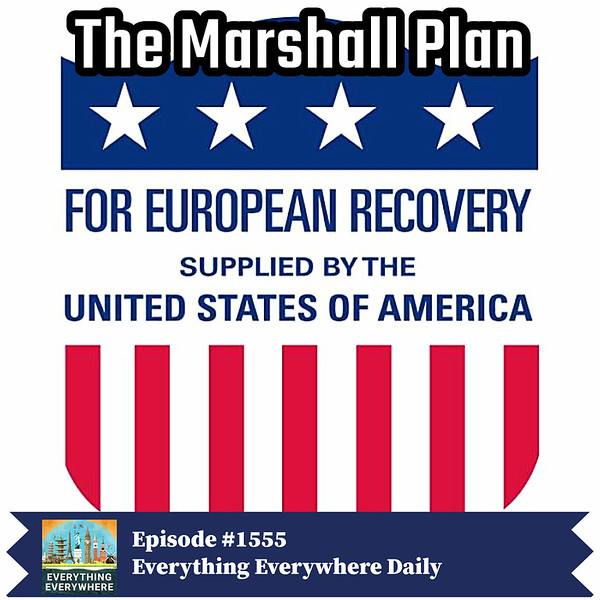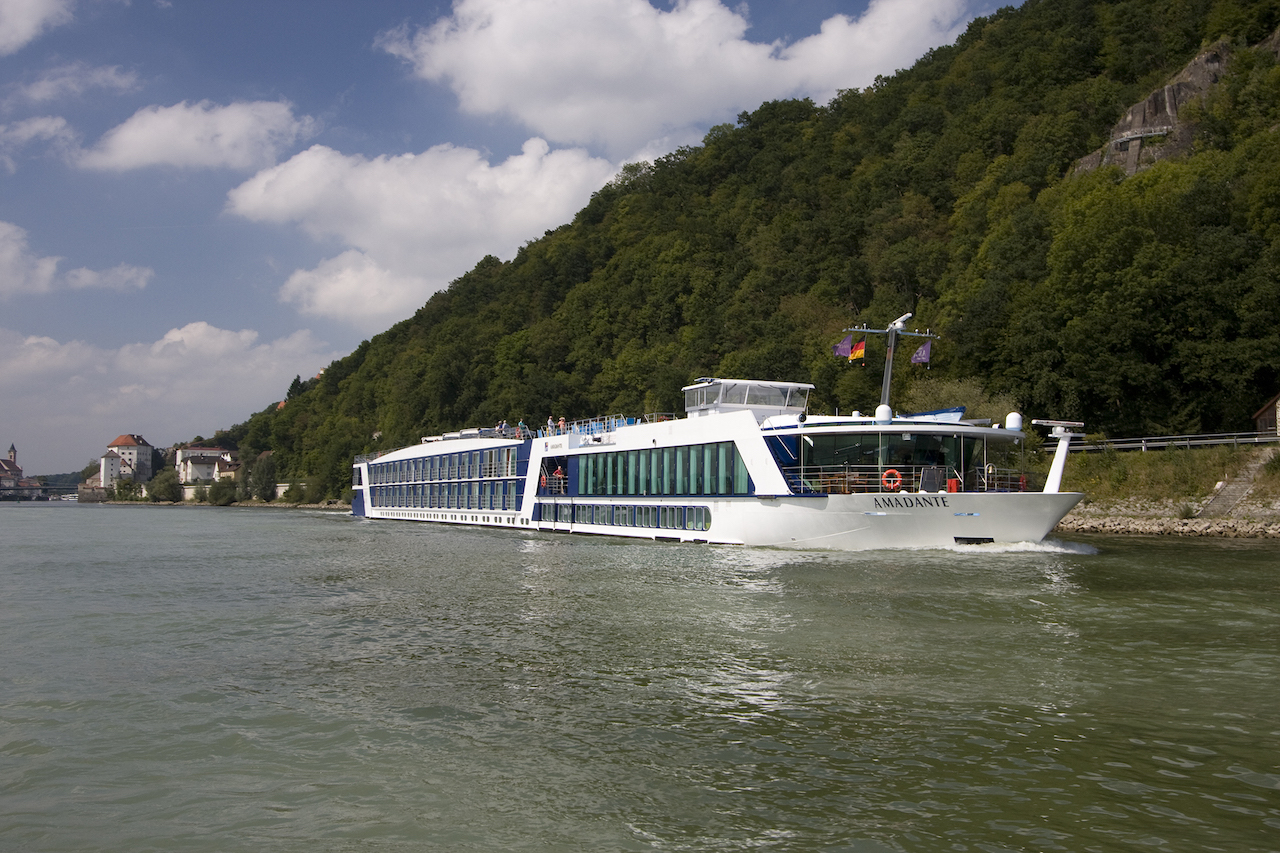Subscribe
Apple | Spotify | Amazon | iHeart Radio | Player.FM | TuneIn
Castbox | Podurama | Podcast Republic | RSS | Patreon
Podcast Transcript
At the end of the Second World War, Europe was a mess. The economies of most countries were in shambles and the threat of communism loomed over the continent.
In a speech at Harvard University on June 5, 1947, U.S. Secretary of State George C. Marshall proposed a plan which could help get Europe back on its feet.
The plan is widely considered one of the most successful foreign aid programs in history.
Learn more about the Marshall Plan, how it came about, and how it worked on this episode of Everything Everywhere Daily.
After the Second World War, Europe was in a very rough state, and that is putting it mildly.
Millions of people had been killed. Industrial centers such as Dresden, Hamburg, London, Birmingham, Cologne, and Liverpool, just to name a few, had been wholly or partially destroyed.
It wasn’t just factories that had been damaged. Europe’s transportation system was also a mess. Bombing runs had destroyed train tracks, train stations, ports, airports, bridges, roads, and tunnels.
The electrical infrastructure was damaged or destroyed in many countries.
Europe’s agricultural system was also on the brink of collapse. There were concerns of famine in 1946 and 1947 because of a lack of manpower and the difficulty of transporting what food was grown.
Unemployment was high which meant that there was reduced demand for goods which further depressed what part of the economy was still intact.
On top of everything, the end of the war didn’t mean the end of the threat of war as the Cold War was now looming over Europe.
Once the war was over, Germany surrendered, and Hitler was dead, the Allies could begin to focus on reconstruction.
The first Allied meeting after the war, was the Potsdam Conference which took place from July 17 to August 2, 1945, the topic of reconstruction was on the table, but nothing was agreed upon.
Through the end of 1945 and 1946, the Western powers, particularly the U.S., became increasingly concerned about the spread of communism into war-ravaged Western Europe, where poverty and instability were widespread.
The winter of 1946–1947 was a severe one in Europe. It exacerbated food and fuel shortages, halted industrial production, and worsened the already fragile economies of many countries. Britain experienced heavy snowfalls, which was highly unusual.
By February 1947, British was facing an economic crisis. They announced that they were no longer able to financially support Greece and Turkey which were both facing communist insurgencies.
This shocked the United States and President Harry Truman. On March 12, before a joint session of Congress, Truman announced what would become known as the Truman Doctrine.
The Truman Doctrine was summarized in his address as follows:
I believe it must be the policy of the United States to support free peoples who are resisting attempted subjugation by armed minorities or by outside pressures.
I believe that we must assist free peoples to work out their own destinies in their own way.
I believe that our help should be primarily through economic and financial aid, which is essential to economic stability and orderly political processes.
Basically, the US didn’t want to sit back and allow communist groups to take over more countries. Truman proposed an aid package for both Turkey and Greece to make up for the loss of British funds.
Here, I need to stress the unique position that the United States found themselves in after the war.
In the 1880s the United States had become the world’s largest economy and in the 1890s they became the world’s most productive economy.
By the start of the Second World War, despite the great depression, they were the world’s largest producer of oil, coal and steel.
By the end of the war, the gap between the United States and everyone else had become enormous. This is largely due to the fact that all of the other major industrial economies were severely damaged from the war whereas the US managed to end with war with its infrastructure fully intact.
After the announcement of the Truman Doctrine, there was an acknowledgment that more needed to be done than just supporting the fight against insurgents.
Also, in early 1947, President Truman sent former President Herbert Hoover on a tour of Europe with a special focus on Germany and Austria.
In March, he delivered a report highlighting the dire economic conditions in post-war Germany and Austria. Hoover recommended that the U.S. shift its approach from punitive measures, like deindustrialization, to fostering economic recovery. He argued that Germany’s recovery was essential for broader European stability, emphasizing that a self-sufficient Germany would help prevent famine, reduce the burden on U.S. aid, and curb the spread of communism.
This was a complete 180-degree turn from the previously proposed strategy for dealing with Germany, which was presented by US Treasury Secretary Henry Morgenthau.
The Morgenthau Plan, which I’ve covered in a previous episode, was to completely deindustrialize Germany and revert it to an agricultural economy so they could never wage war again.
Hoover’s plan for rebuilding Germany rather than deindustrializing it became the basis for US policy.
On June 5, U.S. Secretary of State George C. Marshall delivered a speech at Harvard University, proposing a plan for the United States to provide aid to Europe for its economic recovery.
If you remember from several of my episodes, Marshall was the Chief of Staff of the United States Army during World War II and the nation’s highest-ranking military official until he resigned to become Secretary of State.
Marshall’s speech became the outline of what would become known as the Marshall Plan.
Marshall outlined a plan of economic aid for Europe that would counteract the rising tide of communism and Soviet influence and help create vibrant economies that would be trading partners with the United States.
He stated in the speech, “Our policy is directed not against any country or doctrine but against hunger, poverty, desperation, and chaos.”
The idea was to avoid making the same mistakes that the Allies made after their victory in the First World War.
This wasn’t simply to be a top-down American program. The Americans wanted European input and participation in the program. In July, a conference was held in Paris, to which representatives of European nations, including the Soviet Union, were invited.
The Soviets saw the plan as a means for the U.S. to extend its influence into Europe and undermine Soviet control over Eastern Europe, which admittingly was true.
Soviet Foreign Minister Vyacheslav Molotov initially attended the Paris Conference in July 1947, where European nations discussed the Marshall Plan, but he walked out when it became clear that the U.S. would have a significant role in how the aid was distributed.
While some Eastern European countries, like Czechoslovakia and Poland, were initially interested in participating in the Marshall Plan, the Soviet Union pressured them to reject the offer. Stalin was unwilling to allow these nations to accept American aid, fearing it would erode Soviet control.
In response to the Marshall Plan, the Soviet Union proposed its own version of economic assistance for Eastern European countries, known as the Molotov Plan. This was meant to provide aid and create economic ties between the Soviet Union and its satellite states.
Without going into too much detail, it was not nearly as successful.
Immediately after the Paris Conference, sixteen nations formed the Committee of European Economic Cooperation to coordinate the implementation of the Marshall Plan. This then became the Organization for European Economic Cooperation in April1948.
The Committee of European Economic Cooperation was designed to facilitate not only the implementation of the Marshall Plan, but also greater European economic cooperation.
In a very real sense, this was the seed that decades later sprouted into the European Union.
In late 1947 and early 1948, the ball was put back into the court of the Americans.
Finally, almost nine months after George Marshall’s speech at Harvard, on April 3, 1948, the United States Congress passed the Economic Cooperation Act, aka the Marshall Plan.
The Marshall Plan was intended to be a short-term plan. It was to start in 1948 and was not intended to go beyond 1953, but in reality, the program ended in 1952 due to the increased cost of the Korean War.
The total amount budgeted by the United States over the entirety of the Marshall Plan was $13 billion dollars. That might not sound like a lot today, but it was the equivalent of 5% of the US economy at the time.
If you want to convert that into modern money, there are two ways you could look at it. If you just adjust for inflation the money in today’s dollars would be $170 billion.
However, the US economy has grown substantially since then. If a similar program were to be conducted today at 5% of the US economy, it would be about $1.75 trillion dollars.
The funds were distributed in the form of grants, loans, and in-kind gifts such as food, machinery, and fuel.
There were a total of 18 different European countries that received funds. It included several countries which didn’t even take part in the war including Ireland, Switzerland, and Sweden.
The general distribution of funds was based on population. However, there was a skew towards countries that were allies in the war and against countries like Italy that were belligerents.
The largest recipient was Britian with 26% of the funds, followed by France, and then West Germany.
Overall, 85% of the funds were distributed as grants with 15% given as loans. Again, who received grants vs loans wasn’t even.
Ireland received mostly loans, for example.
A significant portion of the grants was distributed as in-kind gifts, including food, fuel (especially coal), raw materials, and machinery. This helped address immediate shortages and facilitated the recovery of industrial and agricultural production.
Money wasn’t given out willy nilly. It was targeted at specific projects that would improve the economic output, in particular rebuilding roads, bridges, railways, and other essential infrastructure.
When European countries received Marshall Plan aid, they were required to deposit local currency equivalents into special counterpart funds. These funds were then used for local infrastructure and economic development projects, ensuring that the aid had a multiplier effect on domestic economies.
A big part of the Marshall Plan that wasn’t captured in the financial data was an exchange of information. The US Bureau of Labor Statistics managed the Technical Assistance Program. They compiled data for best management practices and shared them with European companies.
They also arranged trips to the US for Europeans to visit US factories and learn management techniques.
Finally, The U.S. required recipient countries to liberalize trade, stabilize their currencies, and foster free-market policies.
The big question that historians have debated is “just how successful was the Marshall Plan?”
By and large, historians and economists have credited the Marshall Plan for the economic recovery of post-war Europe. On a certain level, you can’t really argue with the data.
During the years of the Marshall Plan from 1948 to 1952, European industrial production increased by 35%, and agricultural production surpassed pre-war levels. Countries like West Germany experienced rapid economic recovery, laying the foundation for the “Wirtschaftswunder” (economic miracle) of the 1950s.
Politically, the Marshall Plan strengthened democratic governments and reduced the appeal of communism in Western Europe. It contributed to the stabilization of countries such as Italy and France, where communist parties were gaining influence.
By encouraging cooperation among European countries, the Marshall Plan helped foster economic interdependence, which became a cornerstone of European integration. This cooperation led to the creation of institutions like the European Coal and Steel Community (ECSC) in 1951, which eventually evolved into the European Union.
Furthermore, The Marshall Plan cemented the transatlantic relationship between the U.S. and Europe, with America being seen as a key ally in Europe’s recovery. This laid the foundation for future cooperation, including the creation of NATO in 1949.
Critics of the Marshall Plan note that the actual amount of money that each country received was actually less than 1% of their GDP each year, and this is true.
However, the raw numbers ignore the fact that the Marshall Plan was highly targeted. It was implemented at the right time with proceeds going to specific economic areas where it would do the most good.
Moreover, the non-economic aspects of the plan improved trade and productivity, which can’t be measured in the amount of money given.
The Marshall Plan was a critical component of post-World War II recovery in Europe. It not only helped rebuild war-torn economies but also fostered political stability and economic cooperation, which eventually created the Europe of today.



